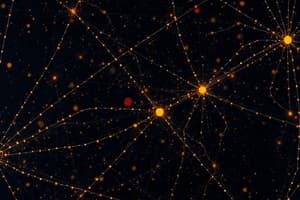Podcast
Questions and Answers
What occurs when the optic nerve is cut?
What occurs when the optic nerve is cut?
- Blindness in the outer visual fields
- Blindness in both eyes
- Blindness in the contralateral eye
- Blindness in the ipsilateral eye (correct)
What type of visual field loss results from cutting the optic chiasm?
What type of visual field loss results from cutting the optic chiasm?
- Scotomas in both eyes
- Quadrantanopia
- Homonymous hemianopia
- Heteronymous bitemporal hemianopia (correct)
What is the effect of cutting the optic tract?
What is the effect of cutting the optic tract?
- Bilateral vision loss
- No loss of vision
- Contralateral hemianopia (correct)
- Ipsilateral visual field loss
What initiates the process of photoreception in rods?
What initiates the process of photoreception in rods?
What role does metarhodopsin II play in phototransduction?
What role does metarhodopsin II play in phototransduction?
What is the effect of decreased cGMP levels in photoreceptors?
What is the effect of decreased cGMP levels in photoreceptors?
What is a consequence of photoreceptor hyperpolarization?
What is a consequence of photoreceptor hyperpolarization?
What vitamin is essential for regenerating 11-cis retinal?
What vitamin is essential for regenerating 11-cis retinal?
Flashcards are hidden until you start studying
Study Notes
Effects of Lesions in the Optic Pathway
- Cutting the optic nerve results in blindness in the ipsilateral eye.
- Cutting the optic chiasm leads to heteronymous bitemporal hemianopia, affecting the outer half of the visual field in both eyes.
- Cutting the optic tract causes homonymous contralateral hemianopia, where both eyes share the same visual field loss.
- Cutting the geniculocalcarine tract results in homonymous hemianopia with macular sparing, meaning the central visual field remains unaffected.
Steps in Photoreception in the Rods
- Rhodopsin is the photosensitive element, consisting of opsin (a G-protein-coupled receptor protein) and retinal (an aldehyde of vitamin A).
- Photoisomerization occurs when light hits the retina, converting 11-cis retinal to all-trans retinal and forming intermediates, including metarhodopsin II.
- Vitamin A is essential for regenerating 11-cis retinal; deficiency leads to nyctalopia (night blindness).
- Metarhodopsin II activates transducin (Gt), a G protein, which then stimulates a phosphodiesterase.
- Phosphodiesterase converts cyclic guanosine monophosphate (cGMP) to 5'-GMP, causing a decrease in cGMP levels.
- Lower cGMP levels result in the closure of Na+ channels, reducing inward Na+ current and causing hyperpolarization of the photoreceptor cell membrane, increasing with light intensity.
- Hyperpolarization decreases the release of glutamate, an excitatory neurotransmitter.
- Two types of glutamate receptors on bipolar and horizontal cells dictate the excitation or inhibition of these cells.
- Excitatory ionotropic glutamate receptors lead to hyperpolarization (inhibition) due to decreased excitation from lowered glutamate release.
Studying That Suits You
Use AI to generate personalized quizzes and flashcards to suit your learning preferences.



